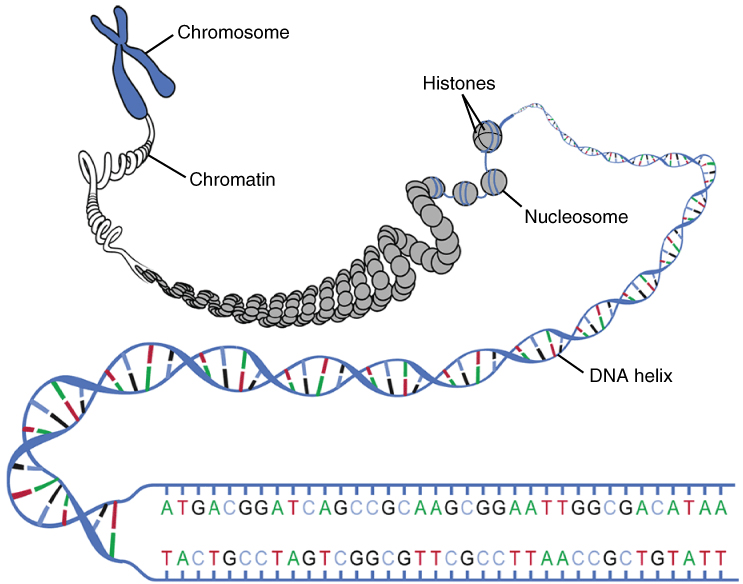
Answer
371.4k+ views
Hint: Chromatin is a complex of RNA, DNA and protein. It is found in eukaryotic cells. The main function of chromatin is to pack very long DNA molecules into a compact shape that stops the strands from getting tangled. It also plays an important role in providing strength to the DNA during cell division.
Complete answer:
Chromatin is visible as an entangled mass of thread-like structures. Chromatin is a complex of macromolecules seen in cells. It consists of DNA, protein and RNA. When a cell is not in the process of dividing, the DNA is present as a part of the chromatin material., Whenever the cell is about to divide, the chromatin material gets arranged into chromosomes.
In a non – dividing cell, synthesis of protein and other processes happen. In order for these processes and protein synthesis to occur, DNA is required to be transcriptionally active. This can only happen when the chromatin is in the form of an entangled mesh and not condensed as a chromosome.
The thick rod-like structures that chromatin condenses into are known as chromosomes. It is visible under a light microscope. This process happens during cell division. So, option B is the wrong answer. The crystalline structure and fine crystals of DNA is produced when the DNA is suspended in the liquid and the water evaporates.

Therefore the correct answer is option ‘A’.
Note: Chromatin is made up of repeating units that are known as nucleosomes. Nucleosomes are made up by coiling DNA that is negatively charged around an octamer of histone proteins that are positively charged. Each nucleosome is made up of two hundred base pairs of Deoxyribonucleic acids. Heterochromatin and euchromatin are sorted based on their appearance under a microscope.
Complete answer:
Chromatin is visible as an entangled mass of thread-like structures. Chromatin is a complex of macromolecules seen in cells. It consists of DNA, protein and RNA. When a cell is not in the process of dividing, the DNA is present as a part of the chromatin material., Whenever the cell is about to divide, the chromatin material gets arranged into chromosomes.
In a non – dividing cell, synthesis of protein and other processes happen. In order for these processes and protein synthesis to occur, DNA is required to be transcriptionally active. This can only happen when the chromatin is in the form of an entangled mesh and not condensed as a chromosome.
The thick rod-like structures that chromatin condenses into are known as chromosomes. It is visible under a light microscope. This process happens during cell division. So, option B is the wrong answer. The crystalline structure and fine crystals of DNA is produced when the DNA is suspended in the liquid and the water evaporates.

Therefore the correct answer is option ‘A’.
Note: Chromatin is made up of repeating units that are known as nucleosomes. Nucleosomes are made up by coiling DNA that is negatively charged around an octamer of histone proteins that are positively charged. Each nucleosome is made up of two hundred base pairs of Deoxyribonucleic acids. Heterochromatin and euchromatin are sorted based on their appearance under a microscope.
Recently Updated Pages
Who among the following was the religious guru of class 7 social science CBSE

what is the correct chronological order of the following class 10 social science CBSE

Which of the following was not the actual cause for class 10 social science CBSE

Which of the following statements is not correct A class 10 social science CBSE

Which of the following leaders was not present in the class 10 social science CBSE

Garampani Sanctuary is located at A Diphu Assam B Gangtok class 10 social science CBSE

Trending doubts
Which are the Top 10 Largest Countries of the World?

Fill the blanks with the suitable prepositions 1 The class 9 english CBSE

How do you graph the function fx 4x class 9 maths CBSE

Give 10 examples for herbs , shrubs , climbers , creepers

Change the following sentences into negative and interrogative class 10 english CBSE

Difference between Prokaryotic cell and Eukaryotic class 11 biology CBSE

The Equation xxx + 2 is Satisfied when x is Equal to Class 10 Maths

Write a letter to the principal requesting him to grant class 10 english CBSE

What organs are located on the left side of your body class 11 biology CBSE




